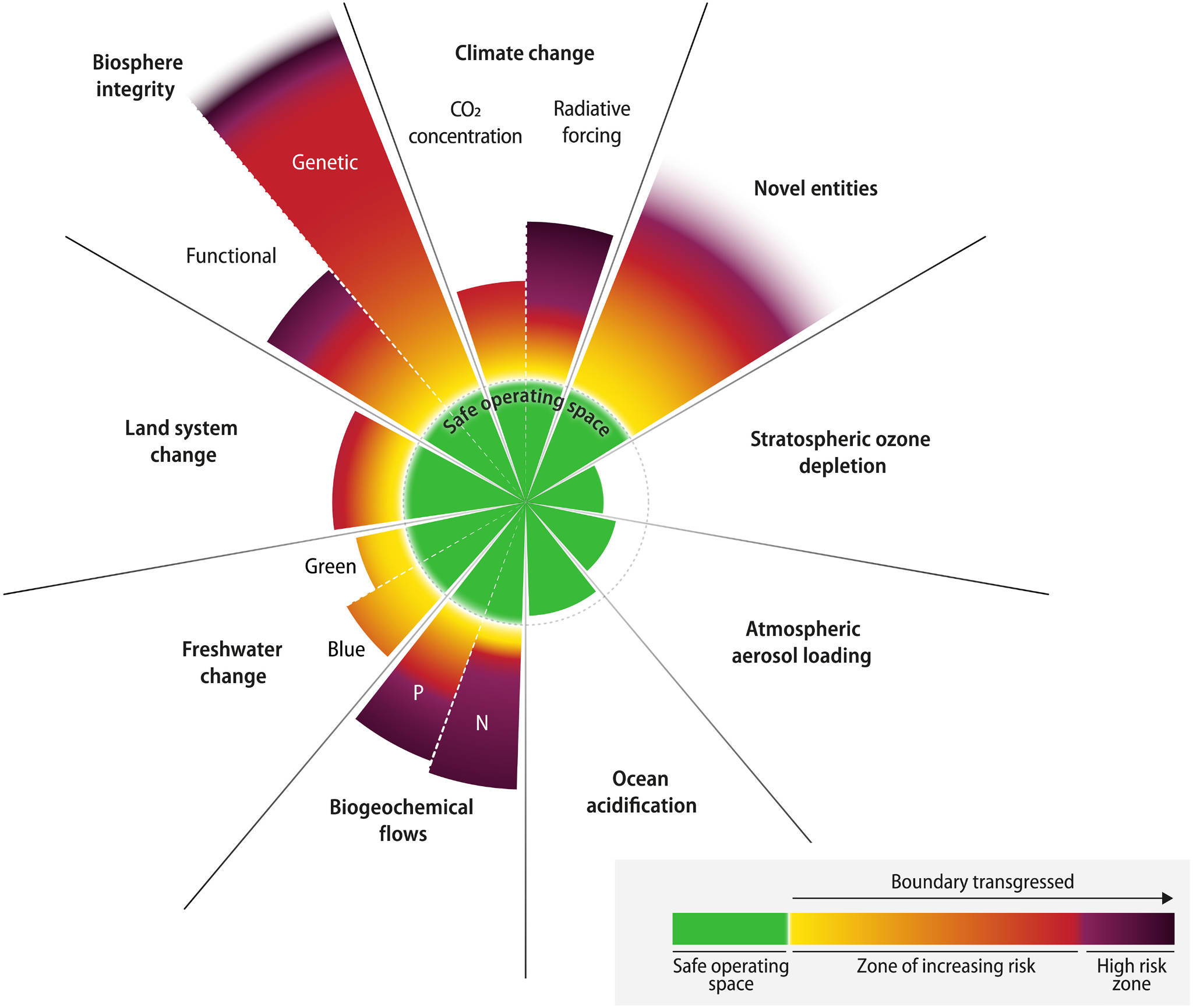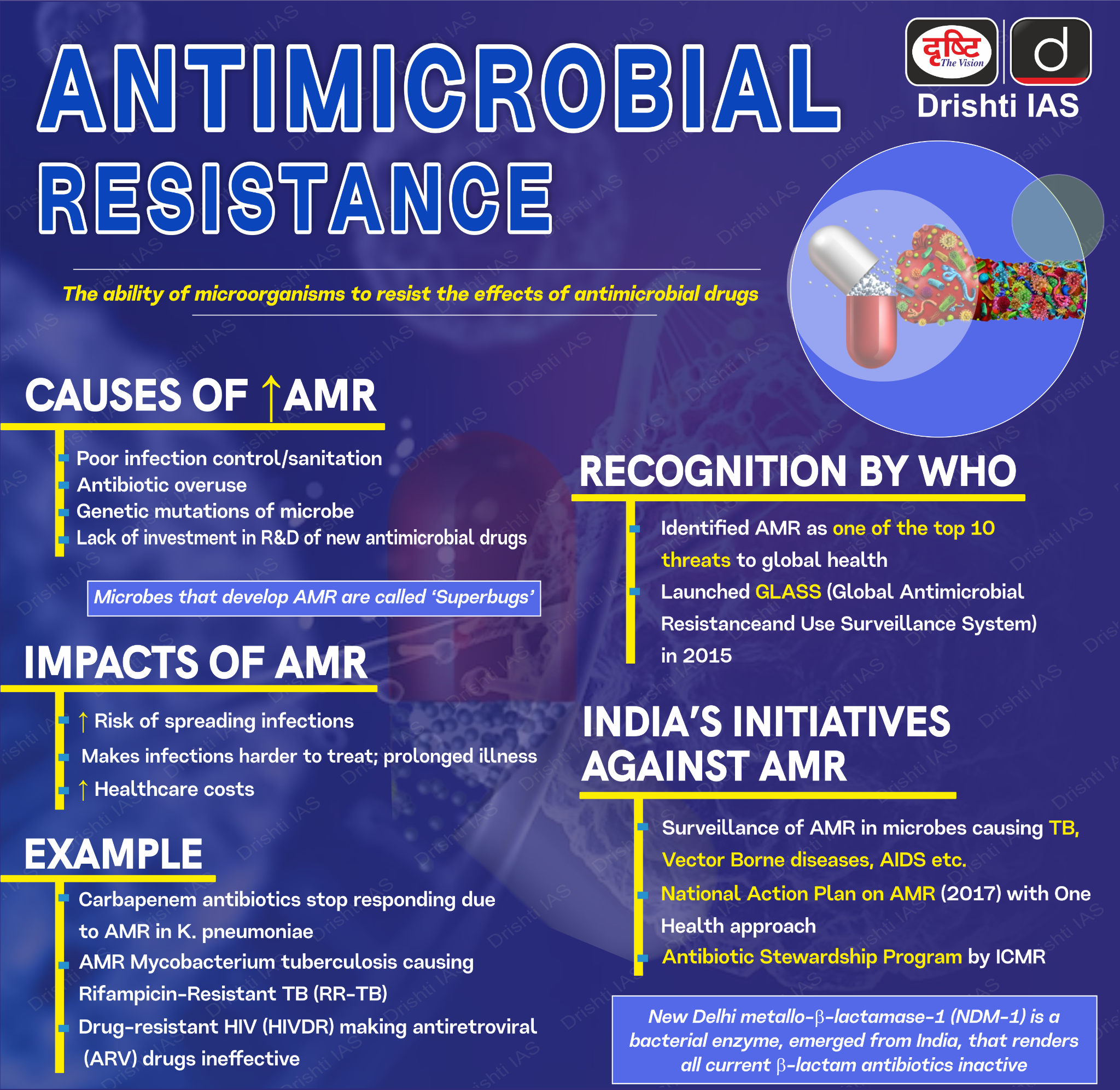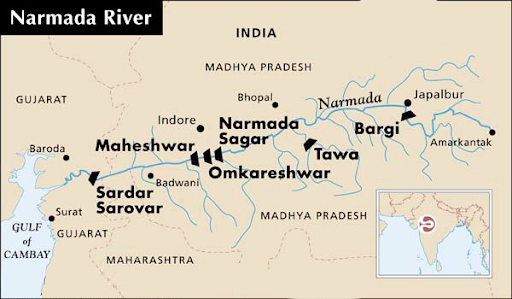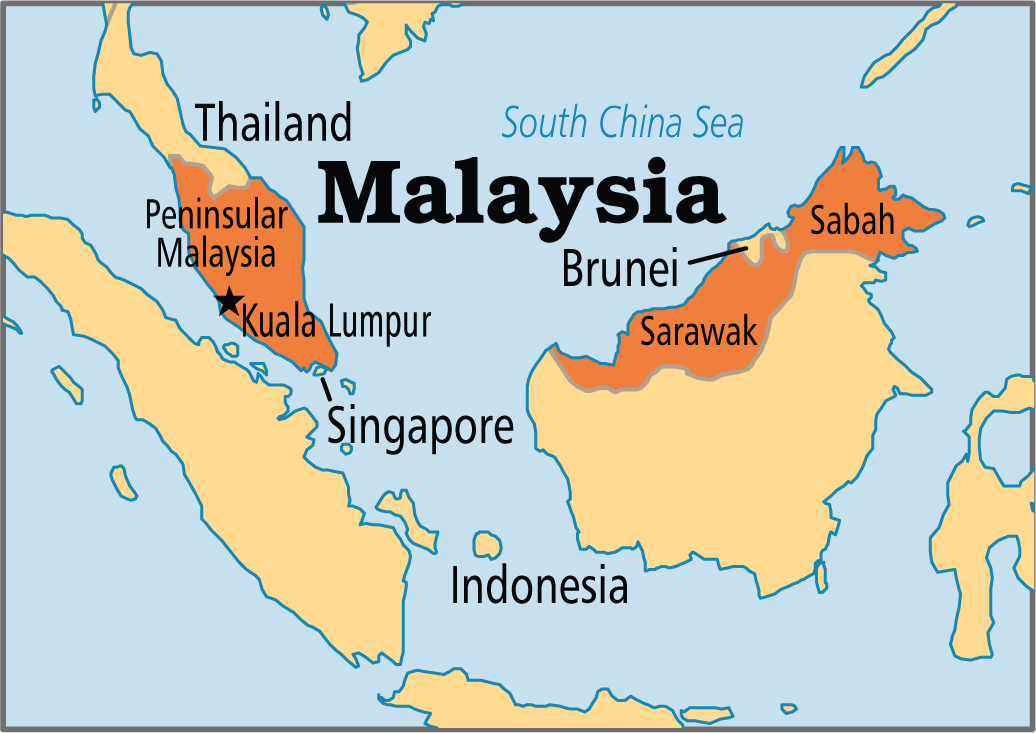Biodiversity & Environment
Planetary Boundaries
For Prelims: Planetary Boundaries, Climate change
For Mains: Importance of Planetary Boundaries in maintaining Earth's stability and biodiversity.
Why in News?
According to a new study, published in the journal Science Advances. The world has breached six out of nine planetary boundaries necessary to maintain Earth's stability and resilience.
- Scientists have investigated the processes within Earth's ecosystem that have played a crucial role in maintaining favorable conditions for human existence over the last 12,000 years.
What Are Planetary Boundaries?
- About:
- The planetary boundaries framework was first proposed by Johan Rockström and a group of 28 internationally renowned scientists in 2009 to define the environmental limits within which humanity can safely operate to maintain Earth's stability and biodiversity.
- Nine Planetary Boundaries:
- Climate change.
- Change in biosphere integrity (biodiversity loss and species extinction)
- Stratospheric ozone depletion.
- Ocean acidification.
- Biogeochemical flows (phosphorus and nitrogen cycles).
- Land-system change (for example deforestation).
- Freshwater use (alterations across the entire water cycle over land).
- Atmospheric aerosol loading (microscopic particles in the atmosphere that affect climate and living organisms).
- Introduction of novel entities(consisting of microplastics, endocrine disruptors, and organic pollutants).
- Breaching Planetary Boundaries:
- Breaching of these boundaries doesn't indicate an immediate catastrophe but raises the risk of irreversible environmental changes.
- This situation could lead to conditions on Earth that no longer support our current way of life.
- Breaching of these boundaries doesn't indicate an immediate catastrophe but raises the risk of irreversible environmental changes.
What are the Key Highlights of the Study?
- Impacted Boundaries:
- Climate Change:
- The researchers set the planetary boundary for atmospheric carbon dioxide concentration and radiative forcing (represents the size of the energy imbalance in the atmosphere) contributing to climate change at 350 parts per million (ppm) and 1 Watts per square meter (Wm−2), respectively. Currently, this has reached 417 ppm and is 2.91 W m−2.
- Biosphere Integrity:
- As for biosphere integrity, the researchers kept a limit of less than 10 extinctions per million species-years. Human-induced species extinctions have far exceeded the safe limit.
- The study estimated the extinction rate was greater than 100 extinctions per million species-years.
- It is estimated that around one million of the 8 million plant and animal species are threatened with extinction.
- Over 10% of the genetic diversity of plants and animals may have been wiped out over the last 150 years.
- Land System Change:
- The global forested land area has dropped below the safe limit of 75%, currently standing at only 60%.
- Freshwater Change:
- Both blue water (surface and groundwater) and green water (available water for plants) have experienced impacts beyond their safe thresholds of 10.2% and 11.1%, respectively in 1905 and 1929, currently at 18.2 % and 15.8 %, respectively.
- Biogeochemical Flows:
- Flows of nutrients like phosphorus and nitrogen in the environment have surged beyond safe limits.
- The boundary was fixed at 11 teragrams (Tg) for Phosphorus and 62 Tg for Nitrogen. This is now 22.6 Tg and 190 Tg, respectively.
- Flows of nutrients like phosphorus and nitrogen in the environment have surged beyond safe limits.
- Novel Entities:
- The planetary boundary of novel entities was calculated to be zero.
- Human influence on novel entities, including microplastics, endocrine disruptors, and organic pollutants, has transgressed the zero boundary. This means humans have transgressed this limit as well.
- Climate Change:
- Safe Boundaries:
- Stratospheric ozone depletion, aerosol loading and ocean acidification were found to be within the planetary boundary.
Way Forward
- Implement conservation programs targeting biodiversity preservation, restoration of ecosystems, and the protection of endangered species and genetic diversity.
- Embracing circularity promotes resource regeneration, minimizing waste and ensuring that valuable materials are continually repurposed rather than discarded.
- Implement strict regulations on waste disposal, encouraging recycling and reducing pollution of novel entities like microplastics.
- Empower communities to actively participate in sustainable practices, cultivating a collective sense of responsibility for environmental stewardship.
- Prioritize climate mitigation strategies to limit temperature rise and prevent further breaches of the planetary boundary related to climate change.
- Promote zero-emission technologies and reduce carbon footprints through incentives for clean energy adoption and sustainable transportation.
UPSC Civil Services Examination, Previous Year Questions (PYQs)
Mains
Q. Discuss global warming and mention its effects on the global climate. Explain the control measures to bring down the level of greenhouse gases that cause global warming, in the light of the Kyoto Protocol, 1997. (2022)


Indian Polity
Fraternity in India
For Prelims: Preamble, 42nd Amendment Act, Fundamental Duties, Constituent Assembly
For Mains: Meaning of Fraternity, Challenges of Achieving ideals of Fraternity
Why in News?
Fraternity, one of the core values enshrined in the Indian Constitution, plays a pivotal role in fostering unity and equality in society. However, the practical application of fraternity in India raises several questions and challenges.
What is the Origin of the Concept of Fraternity?
- Ancient Greece:
- Fraternity, the idea of brotherhood and unity, has a long history.
- In Plato’s Lysis, the philosopher invokes the word philia (love) for the strong desire to pursue wisdom.
- In this context, fraternity was seen as the strong desire to share knowledge and wisdom with others, making friendship more meaningful through intellectual exchange.
- Aristotle's Idea:
- Aristotle, the Greek philosopher, added to the idea of fraternity by highlighting the importance of the "polis," the city-state where people belonged as political beings and friendships among citizens in a city-state (polis) is crucial.
- Middle Ages:
- During the Middle Ages, fraternity took on a different dimension, primarily within the Christian context in Europe.
- Here, fraternity was often associated with religious and communal bonds.
- It was fostered through shared religious beliefs and practices, emphasizing a sense of brotherhood among believers.
- During the Middle Ages, fraternity took on a different dimension, primarily within the Christian context in Europe.
- French Revolution:
- French Revolution in 1789, which gave rise to the famous motto "liberté, égalité, fraternité" (liberty, equality, fraternity).
- This marked the introduction of fraternity into the realm of politics, alongside liberty and equality.
- Fraternity, in this context, symbolized the idea of unity and solidarity among citizens as they fought for their rights and freedom.
- This marked the introduction of fraternity into the realm of politics, alongside liberty and equality.
- French Revolution in 1789, which gave rise to the famous motto "liberté, égalité, fraternité" (liberty, equality, fraternity).
What is the Concept of Fraternity in India?
- India's fraternity has its own journey within India's sociology, and the current nature of India's fraternity is different from the political fraternity espoused in its Constitution.
- Fraternity is a constitutional value in India, alongside liberty and equality, aimed at achieving social harmony and unity.
- The framers of the Indian Constitution recognized the importance of fraternity in a society marred by hierarchical social inequalities.
- Dr. Bhim Rao Ambedkar stressed the inseparability of liberty, equality, and fraternity, considering them as fundamental tenets of Indian democracy.
- Constitutional Provisions Related to Fraternity:
- Preamble:
- The principle of fraternity was added to the principles in the Preamble along with liberty, equality, and justice.
- Fundamental Duties:
- Article 51A on Fundamental Duties, added to by the 42nd Amendment in 1976 and further amended by 86th Amendment (2002).
- Article 51A(e) generally refers to the duty of every citizen ‘to promote harmony and the spirit of common brotherhood amongst all the people of India.’
- Preamble:
What are the Limits and Challenges to Fraternity in India’s Context?
- Social and Cultural Differences:
- India's diverse cultures and traditions can lead to misunderstandings and conflicts among different communities.
- Religious or caste-based differences often result in mistrust, discrimination, and even violence, eroding the spirit of brotherhood.
- Incidents of religious intolerance or conflicts can disrupt social cohesion and unity, making it difficult to foster fraternity.
- Religious minorities have faced such social and political opprobrium countless times in this country.
- India's diverse cultures and traditions can lead to misunderstandings and conflicts among different communities.
- Economic Disparities:
- The significant economic gap between different sections of society can breed resentment and feelings of discrimination.
- When people perceive economic barriers to their success, they may hesitate to cooperate, hindering social cohesion, a crucial element of fraternity.
- Political Differences:
- Political ideologies can create deep divisions in society, impeding cooperation and dialogue.
- Such differences often lead to polarization, fostering an atmosphere of hostility and intolerance that obstructs constructive engagement.
- Political ideologies can create deep divisions in society, impeding cooperation and dialogue.
- Lack of Trust:
- A lack of mutual trust and understanding among groups can undermine fraternity.
- When trust is lacking, working together toward common goals becomes challenging.
- Failure of Constitutional Morality:
- Constitutional morality, based on Indian constitutional values, is vital for maintaining fraternity.
- Its failure can lead to a loss of confidence in institutions and the rule of law, creating instability and undermining brotherhood.
- Constitutional morality, based on Indian constitutional values, is vital for maintaining fraternity.
- Inadequate Moral Order:
- A functioning moral order in society, including adherence to ethical values and social responsibility, is crucial for democracy's success.
- Failure in this area can result in the erosion of brotherhood, with unethical actions eroding trust among citizens.
- Educational Disparities:
- Disparities in access to quality education can perpetuate social inequalities and hinder fraternity.
- Educational inequities often result in unequal opportunities, reinforcing divisions among communities.
- Regional Disparities:
- India's vast geographical and regional diversity can lead to disparities in economic development and infrastructure.
- These regional inequalities may create a sense of marginalization among certain communities, challenging efforts to promote brotherhood.
- Language and Cultural Barriers:
- India's multitude of languages and dialects can sometimes create communication barriers.
- Language and cultural differences can hinder effective dialogue and cooperation, affecting the spirit of fraternity.
- India's multitude of languages and dialects can sometimes create communication barriers.
Way Forward
- Initiatives that promote social and cultural harmony among diverse communities are essential to overcoming differences and fostering a sense of brotherhood. These programs should encourage dialogue, understanding, and cooperation among people of different backgrounds.
- Civic education should instill values of fraternity, equality, and social justice from a young age. Ethical leadership at all levels of society is essential to set an example of responsible citizenship and moral conduct.
- Encouraging respect for religious and cultural diversity is vital. Interfaith dialogues, protections for religious and cultural minorities, and promoting a culture of tolerance can help maintain social cohesion.
- Encourage ethical leadership at all levels of society to set an example of moral conduct and responsible citizenship.
- Implement policies and programs that address economic disparities, ensuring equitable access to opportunities and resources for all citizens.
UPSC Civil Services Examination Previous Year’s Questions (PYQs)
Prelims:
Q. Which one of the following objectives is not embodied in the Preamble to the Constitution of India? (2017)
(a) Liberty of thought
(b) Economic liberty
(c) Liberty of expression
(d) Liberty of belief
Ans: (b)
Exp:
- Preamble to the Constitution of India WE, THE PEOPLE OF INDIA, having solemnly resolved to constitute India into a SOVEREIGN SOCIALIST SECULAR DEMOCRATIC REPUBLIC and to secure to all its citizens:
- JUSTICE, social, economic and political;
- LIBERTY of thought, expression, belief, faith and worship;
- EQUALITY of status and of opportunity;and to promote among them all
- FRATERNITY assuring the dignity of the individual and the unity and integrity of the Nation;
- IN OUR CONSTITUENT ASSEMBLY this twentysixth day of November, 1949, do HEREBY ADOPT, ENACT AND GIVE TO OURSELVES THIS CONSTITUTION.
- The Preamble does not embody the economic liberty.
- Therefore, option (b) is the correct answer.
Mains
Q. Discuss each adjective attached to the word ‘Republic’ in the ‘Preamble’. Are they defendable in the present circumstances? (2016)


Governance
Global Trends in Antimicrobial Use in Animals
For Prelims: Global Trends in Antimicrobial Use in Animals, World Organisation for Animal Health, World Trade Organization (WTO), Antimicrobial Resistance (AMR)
For Mains: Global Trends in Antimicrobial Use in Animals.
Why in News?
Recently, the World Organisation for Animal Health (WOAH) has released its 7th report on Antimicrobial use in animals, covering the period from 2017 to 2019.
- 157 participants submitted data to WOAH for the analysis, but only 121 provided quantitative data for at least one year. 74 participants reported specific amounts of antimicrobial products categorize by type of use and administration route.
- The analysis is based on the data provided by the 80 countries that consistently updated on antimicrobial use in animals.
What is the World Organisation for Animal Health (WOAH)?
- WOAH (founded as OIE) is one of the standard-setting bodies recognized by the Agreement on the Application of Sanitary and Phytosanitary Measures.
- It is an intergovernmental organization responsible for improving animal health worldwide.
- In 2018, it had a total of 182 Member Countries. India is one of the member countries.
- WOAH develops normative documents relating to rules that Member Countries can use to protect themselves from the introduction of diseases and pathogens. One of them is the Terrestrial Animal Health Code.
- WOAH standards are recognised by the World Trade Organization (WTO) as reference international sanitary rules.
- It is headquartered in Paris, France.
What are the Findings of the Report?
- Dip in AntiMicrobial Use:
- There is a 13% decrease in global antimicrobial usage in animals three years from 2017 to 2019.
- Out of 80 countries, 49 in Asia, Far East, Oceania, and Europe reported an overall reduction in antimicrobial use.
- Conversely, 31 countries in African and American regions reported an overall increase in antimicrobial usage during the same period.
- Antimicrobial Growth Promoters:
- 68% of the participants have discontinued using antimicrobials as growth promoters.
- 26% of participants continue to use growth promoters, often due to a lack of proper legislation or regulations.
- Common antimicrobial growth promoters included flavomycin, bacitracin, avilamycin, and tylosin.
- While flavomycin and avilamycin are currently excluded from human use, bacitracin is not classified among WHO’s critically important antimicrobials (CIAs).
- Some of these are classified as CIAs or highest priority CIAs (HP-CIAs).
- Recommendations:
- Despite progress and shifts in usage, continued efforts are deemed crucial to preserve the efficacy of antimicrobials.
- Safeguarding existing antibiotic effectiveness is highlighted as a shared responsibility given the challenges in developing new antibiotics.
- It is important to monitor how, when and which antimicrobials are used becomes critical to identify patterns and trends.
- This can facilitate decision-making and support the implementation of measures to ensure an optimal and sustainable use of these key medicines.
What are Antimicrobial Drugs?
- About:
- Antimicrobial drugs, commonly known as Antibiotics, are substances that either kill or inhibit the growth of microorganisms such as bacteria, fungi, viruses, and parasites.
- They are used to treat or prevent infections in humans, animals, and sometimes plants.
- These drugs are a crucial tool in modern medicine for controlling and eradicating various microbial diseases.
- Concerns:
- Prior to the discovery of penicillin by Alexander Fleming in 1928, infections due to minor cuts could lead to bloodstream infections or death. Yet, today, these life-saving drugs are losing their efficacy due to their misuse and overuse in different sectors.
- The phenomenon is known as ‘Antimicrobial Resistance (AMR)’. It can originate in animal, human or plant populations, and then pose a threat to all the other species.
What are the Initiatives to Tackle Antimicrobial Resistance?
- India:
- National Programme on AMR Containment: Launched in 2012. Under this programme, AMR Surveillance Network has been strengthened by establishing labs in State Medical College.
- National Action Plan on AMR: It focuses on One Health approach and was launched in April 2017 with the aim of involving various stakeholder ministries/departments.
- AMR Surveillance and Research Network (AMRSN): It was launched in 2013, to generate evidence and capture trends and patterns of drug resistant infections in the country.
- AMR Research & International Collaboration: Indian Council of Medical Research (ICMR) has taken initiatives to develop new drugs /medicines through international collaborations in order to strengthen medical research in AMR.
- Antibiotic Stewardship Program: ICMR has initiated antibiotic stewardship program (AMSP) on a pilot project across India to control misuse and overuse of antibiotics in hospital wards and ICUs.
- Global:
- World Antimicrobial Awareness Week (WAAW):
- Held annually since 2015, WAAW is a global campaign that aims to raise awareness of antimicrobial resistance worldwide and encourage best practices among the general public, health workers and policy makers to slow the development and spread of drug-resistant infections.
- The Global Antimicrobial Resistance and Use Surveillance System (GLASS):
- WHO launched the GLASS in 2015 to continue filling knowledge gaps and to inform strategies at all levels.
- GLASS has been conceived to progressively incorporate data from surveillance of AMR in humans, surveillance of the use of antimicrobial medicines, AMR in the food chain and in the environment.
- Global Database for ANImalantiMicrobial USE (ANIMUSE):
- It is an online platform facilitating data accessibility to support evidence-based decision-making.
- Global High-Level Ministerial Conference:
- The Third Global High-Level Ministerial Conference on Antimicrobial Resistance in 2022 saw commitments from 47 countries to reduce antimicrobial use in animals and agriculture by 30-50% by 2030.
- World Antimicrobial Awareness Week (WAAW):
UPSC Civil Services Examination, Previous Year Question (PYQ)
Prelims
Q. Which of the following are the reasons for the occurrence of multi-drug resistance in microbial pathogens in India? (2019)
- Genetic predisposition of some people
- Taking incorrect doses of antibiotics to cure diseases
- Using antibiotics in livestock farming
- Multiple chronic diseases in some people
Select the correct answer using the code given below.
(a) 1 and 2
(b) 2 and 3 only
(c) 1, 3 and 4
(d) 2, 3 and 4
Ans: (b)
Mains
Q. Can overuse and free availability of antibiotics without Doctor’s prescription, be contributors to the emergence of drug-resistant diseases in India? What are the available mechanisms for monitoring and control? Critically discuss the various issues involved. (2014)


Biodiversity & Environment
Shrinking Lion Numbers in Africa
For Prelims: Lion Conservation, African and Asian Lions
For Mains: Initiatives related to Conservation of Lions
Why in News?
The Study by Journal Nature Communications highlighted the concerns with respect to the population of Lions lying well below the carrying capacity across 62 geographic locations of African countries which also have socio-economic connotation to that.
- The Lion Population were estimated to be between 20,000 and 25,000 in number and may be declining, as per the study.
What are the Key Highlights of the Study?
- Across 62 geographic locations of Africa, around 41.9% of the regions had less than 50 lions and 10 of them reported to have around 50-100 population of Lions.
- Only seven geographic locations across Africa were reported to have more than 1000 lion populations.
- The lions face other threats such as poaching for prey, indiscriminate killing due to human-lion conflict, bushmeat and others, which are evidently found in eastern and southern Africa
- Bushmeat poaching with snares led to local extinction of lions in Nsumbu National Park in Zambia and Limpopo National Park in Mozambique, which are two major national parks related to conservation of lions.
- The research observed that southern African countries such as Botswana, South Africa, Zimbabwe and Namibia have recorded an increase of population by 12% between 1993 and 2014.
- But the remaining lion habitats have seen a decline by 60%, especially in west and central Africa.
What are the Key Points Related to Lion?
- Scientific Name: Panthera leo
- About:
- The lion is divided into two subspecies: the African lion (Panthera leo leo) and the Asiatic lion (Panthera leo persica).
- Asiatic lions are slightly smaller than African lions.
- The most striking morphological character, which is always seen in Asiatic lions, and rarely in African lions, is a longitudinal fold of skin running along its belly.
- Role in the Animal Kingdom:
- Lions hold an indispensable place in the ecosystem, they are an apex predator of their habitat, responsible for checking the population of grazers, thus helping in maintaining the ecological balance.
- Lions also contribute to keeping the population of their prey healthy and resilient as they target the weakest members of the herd. Thus, indirectly helping in disease control in the prey population.
- Threats:
- Poaching, genetic inbreeding arising from a single population inhabiting one place, diseases such as plague, canine distemper or a natural disaster.
- Protection Status:
- IUCN Red List: Vulnerable
- Asiatic Lion - Endangered.
- CITES: Appendix I for populations of India, all other populations are included in Appendix II.
- Wildlife (Protection) Act 1972: Schedule I
- IUCN Red List: Vulnerable
- Status in India:
- India is home to the majestic Asiatic Lion, who inhabit the protected territory of Sasan-Gir National Park (Gujarat).
- The lion population escalated from 523 to 674 individuals between the years 2015 and 2020.
- Population of Lion in the World:
- As per the estimates by IUCN, the population of lions is estimated to be around 23000 to 39000 overall, mostly spread across the Saharan Countries.
What are Conservation Efforts in India for Lions?
- Project Lion: The programme has been launched for the conservation of the Asiatic Lion, whose last remaining wild population is in Gujarat’s Asiatic Lion Landscape.
- Asiatic Lion Conservation Project: The project envisages scientific management with the involvement of communities in coordination with multi-sectoral agencies for disease control and veterinary care for overall conservation of Asiatic lion.
UPSC Civil Services Examination Previous Year Question (PYQ)
Q. Consider the following statements: (2019)
- Asiatic lion is naturally found in India only.
- Double-humped camel is naturally found in India only.
- One-horned rhinoceros is naturally found in India only.
Which of the statements given above is/are correct?
(a) 1 only
(b) 2 only
(c) 1 and 3 only
(d) 1, 2 and 3
Ans: (a)


Important Facts For Prelims
Initiatives for Agriculture
Why in News?
Recently, the Ministry of Agriculture (MoA&FW) has launched three initiatives, namely the Kisan Rin Portal (KRP), KCC Ghar Ghar Abhiyaan and a manual on Weather Information Network Data Systems (WINDS).
- These initiatives aim to revolutionize agriculture, enhance financial inclusion, optimize data utilization, and improve the lives of farmers across the nation.
What are the Key Points of these Schemes?
- Kisan Rin Portal (KRP):
- Developed through a collaborative effort involving MoA&FW, Ministry of Finance, RBI, and NABARD, the KRP aims to revolutionize access to credit services under the Kisan Credit Card (KCC) scheme.
- It facilitates farmers in availing subsidized agriculture credit through the Modified Interest Subvention Scheme (MISS).
- The portal offers an integrated hub, providing a comprehensive view of farmer data, loan disbursement specifics, interest subvention claims, and scheme utilization progress.
- Ghar-Ghar KCC Abhiyaan:
- The "Ghar-Ghar KCC Abhiyaan" underscores government commitment to Universal Financial Inclusion, ensuring every farmer has unhindered access to credit facilities crucial for their agricultural pursuits.
- This campaign, starting from 1st October 2023 to 31st December 2023, targets the saturation of KCC accounts among eligible PM KISAN beneficiary farmers.
- The ministry has verified existing KCC account holders' data against the PM KISAN database, identifying those with KCC accounts and those without.
- The campaign aims to reach out to non-KCC account holder PM KISAN beneficiaries and facilitate their seamless integration into the KCC scheme.
- The "Ghar-Ghar KCC Abhiyaan" underscores government commitment to Universal Financial Inclusion, ensuring every farmer has unhindered access to credit facilities crucial for their agricultural pursuits.
- Launch of WINDS Manual:
- The WINDS initiative is an effort aimed at establishing a network of Automatic Weather Stations & Rain Gauges at taluk/block and gram panchayat levels.
- This initiative creates a robust database of hyper-local weather data, supporting various agricultural services.
- The comprehensive WINDS manual launched provides stakeholders with an in-depth understanding of the portal's functionalities, data interpretation, and effective utilization.
- It guides States and Union Territories in establishing and integrating with the WINDS platform.
- Additionally, it offers practical insights into leveraging weather data for improved crop management, resource allocation, and risk mitigation.
What are the Initiatives Related to Agriculture?
- Mission Organic Value Chain Development for North Eastern Region (MOVCDNER)
- National Mission on Sustainable Agriculture
- Paramparagat Krishi Vikas Yojana (PKVY)
- Sub-mission on AgroForestry (SMAF)
- Rashtriya Krishi Vikas Yojana
- AgriStack
- Digital Agriculture Mission
- Unified Farmer Service Platform (UFSP)
- National e-Governance Plan in Agriculture (NeGP-A)
UPSC Civil Services Examination Previous Year Question (PYQ)
Q1. Under the Kisan Credit Card scheme, short-term credit support is given to farmers for which of the following purposes? (2020)
- Working capital for maintenance of farm assets
- Purchase of combine harvesters, tractors and mini trucks
- Consumption requirements of farm households
- Post-harvest expenses
- Construction of family house and setting up of village cold storage facility
Select the correct answer using the code given below:
(a) 1, 2 and 5 only
(b) 1, 3 and 4 only
(c) 2, 3, 4 and 5 only
(d) 1, 2, 3, 4 and 5
Ans: (b)
Exp:
- The Kisan Credit Card (KCC) scheme was introduced in 1998 for providing adequate and timely credit support from the banking system under a single window with flexible and simplified procedure to the farmers for their cultivation and other needs like purchase of agriculture inputs such as seeds, fertilizers, pesticides etc. and draw cash for their production needs.
- The scheme was further extended in the year 2004 for the investment credit requirement of farmers viz allied and non-farm activities.
- KCC is provided with the following objectives:
- The short term credit requirements for cultivation of crops,
- Post harvest expenses, hence 4 is correct.
- Produce marketing loan,
- Consumption requirements of farmer household, hence 3 is correct.
- Working capital for maintenance of farm assets and activities allied to agriculture, like dairy animals, inland fishery, etc., hence, 1 is correct.
- Investment credit requirement for agriculture and allied activities like pumpsets, sprayers, dairy animals, etc. However, this segment forms the long term credit limit portion.
- The KCC Scheme is implemented by Commercial Banks, RRBs, Small Finance Banks and Cooperatives.
- The short term credit support is not given to farmers for Purchase of combine harvesters, tractors and mini trucks and Construction of family house and setting up of village cold storage facility. Hence, 2 and 4 is not correct.
- Therefore, option (b) is the correct answer.


Important Facts For Prelims
Narmada River
Why in News?
Narmada and other rivers have caused widespread flooding in Gujarat and cut off various villages from the mainstream in the southern and central regions of the State.
- The water level of the Narmada is beyond the danger mark and the India Meteorological Department (IMD) issued red and orange alerts in parts of Gujarat.
- Narmada River’s major dam is Sardar Sarovar Dam, which is one of the important reasons behind the rising levels.
What is the Sardar Sarovar Project ?
- About:
- The Sardar Sarovar project is the Gravity dam on Narmada River crossing Gujarat.
- Gravity dam is constructed of concrete or stone designed to transfer the entire water load downward.
- It is primarily meant for large scale irrigation and Hydroelectric multi-purpose projects.
- The Sardar Sarovar project is the Gravity dam on Narmada River crossing Gujarat.
- Features:
- The Project was conceived in 1979 majorly for the purposes of Agricultural and Mitigating power Crisis in the state.
- The Hydro electric Power generated would be shared between the states of Gujarat, Madhya Pradesh, and Maharashtra, whereas the irrigation benefits can be utilized by Gujarat and Rajasthan.
What are Key Facts of Narmada River?
- About:
- The Narmada River (also known as Rewa) serves as a traditional boundary between North and South India.
- It is 1,312 km west of its origin from the Amarkantak peak of Maikal mountain. It flows into the Gulf of Khambhat.
- It drains a large area in Madhya Pradesh besides some areas in the states of Maharashtra and Gujarat.
- It is a West flowing river of the peninsular region flowing through a rift valley between the Vindhya Range on the north and the Satpura Range on the south.
- Tributaries:
- The predominant tributaries from the right are – Hiran, Tendori, Barna, Kolar, Man, Uri, Hatni, and Orsang.
- The predominant left tributaries are – Burner, Banjar, Sher, Shakkar, Dudhi, Tawa, Ganjal, Chhota Tawa, Kundi, Goi, and Karjan.
- Dams:
- The Major dams on the river include Omkareshwar and Maheshwar dams.
What are the Different Color-coded Alerts Issued by the IMD?
- The IMD uses 4 colour codes are:
- Green (All is well): No advisory is issued.
- Yellow (Be Aware): Yellow indicates severely bad weather spanning across several days. It also suggests that the weather could change for the worse, causing disruption in day-to-day activities.
- Orange/Amber (Be prepared): The orange alert is issued as a warning of extremely bad weather with the potential of disruption in commute with road and rail closures, and interruption of power supply.
- Red (Take Action): When the extremely bad weather conditions are certainly going to disrupt travel and power and have significant risk to life, the red alert is issued.
Q 1. The Narmada River flows to the west, while most other large peninsular rivers flow to the east. Why? (2013)
- It occupies a linear rift valley.
- It flows between the Vindhyas and the Satpuras.
- The land slopes to the west from Central India.
Select the correct answer using the codes given below:
(a) 1 only
(b) 2 and 3
(c) 1 and 3
(d) None
Ans: (a)


Important Facts For Prelims
Patient Safety Rights Charter of WHO
Why in News?
Ahead of World Patient Safety Day (17th September, 2023), the World Health Organization (WHO) released the first-ever Patient Safety Rights Charter, focusing on safeguarding patients in healthcare contexts.
- WHO advocates transitioning from a blame-oriented approach to a system-based perspective, focusing on understanding the underlying systemic errors in medical care.
- The theme for World Patient Safety Day 2023 is ‘Engaging patients for patient safety’.
What is Patient Safety?
- About:
- Patient safety encompasses efforts to prevent unintended harm during healthcare provision, a critical aspect of global healthcare.
- Factors Contributing to Patient Harm:
- Identified Sources of Harm: Medication errors, surgical errors, healthcare-associated infections, sepsis, diagnostic errors, and patient falls as frequent causes of patient harm.
- Varied Factors: Patient harm arises from system and organizational failures, technological limitations, human factors, and patient-related circumstances, illustrating the multi-dimensional nature of patient safety incidents.
What is the Patient Safety Rights Charter?
- About:
- The charter outlines the core rights of all patients in the context of safety of health care and seeks to assist governments and other stakeholders to ensure that the voices of patients are heard and their right to safe health care is protected.
- Need:
- Approximately 1 in 10 patients encounter harm during healthcare procedures, resulting in over 3 million annual deaths attributed to unsafe care, as reported by the Organisation for Economic Co-operation and Development (OECD).
- According to the OECD, investing in patient safety positively impacts health outcomes, reduces costs related to patient harm, improves system efficiency, and helps in reassuring communities and restoring their trust in health care systems.
- The majority of patient harm is avoidable, underscoring the vital role of engaging patients, families, and caregivers in minimizing harm.
- A 2023 survey of WHO Member States revealed gaps in implementing the Global Patient Safety Action Plan 2021-2030, emphasizing the need for patient representation and addressing income-based disparities in implementation.
- Interim results of the survey showed only 13% of responding countries have a patient representative on the governing board or an equivalent mechanism in the majority of their hospitals.
- Approximately 1 in 10 patients encounter harm during healthcare procedures, resulting in over 3 million annual deaths attributed to unsafe care, as reported by the Organisation for Economic Co-operation and Development (OECD).


Rapid Fire
Rapid Fire Current Affairs
India-Malaysia Defence Cooperation Committee Meeting
- The 12th meeting of the Malaysia-India Defence Cooperation Committee (MIDCOM) took place in New Delhi on 19th September 2023.
- The meeting reviewed the outcomes of two sub-committee meetings, namely the Sub-Committee on Military Cooperation (27th July 2023) and the Joint Sub-Committee on Defence Science Technology and Industry Cooperation (18th September 2023).
- The Defence Secretary of India shared an 8-point proposal with the Malaysian side to expand cooperation between India and Malaysia on a wide range of areas such as Government to government-level engagement, Tri-Service cooperation, Training, UN Peacekeeping, Bilateral Services Engagement, Defence Industrial Cooperation, Research & Development and Regional/ Sub-Regional Engagements.
- Both countries reaffirmed their commitment to fully implement the Enhanced Strategic Partnership, emphasizing mutual trust, common interests, and shared values of democracy and the rule of law.
Read more: India-Malaysia Defence Cooperation
Biohacking
- Biohacking has gained more attention and popularity in recent years, it is the practice of modifying or enhancing one’s own body or biology using various methods, such as diet, supplements, devices, implants, or genetic engineering.
- Biohacking can have different goals, such as improving health, performance, well-being, or appearance, or exploring the limits and possibilities of human nature.
- The most well-known type of biohacking is genetic engineering, where individuals experiment with new technologies to enhance their physical appearance or capabilities.
- However, biohacking also raises ethical and safety concerns, particularly when individuals engage in risky or unproven procedures.
String Technology and its Impact on Lithium Production
A new technology called "String" has emerged, with the potential to streamline the extraction of lithium, a crucial component in batteries used in smartphones and electric vehicles.
- Lithium production is a resource intensive and time-consuming process as most of the Lithium produced in the world is extracted from Brine Reservoirs,located in Salt flats.
- String Technology involves the use of porous fibres twisted into strings, which have been meticulously engineered.
- These strings possess a water-loving (hydrophilic) core and a water-repelling surface.
- When one end of the string is immersed in a saltwater solution, capillary action is initiated, mimicking the way trees transport water from their roots to their leaves.
- As the water evaporates from the string's surface, it leaves behind salt ions, including sodium and lithium. Over time, as the salts become increasingly concentrated, they form sodium chloride and lithium chloride crystals, which can be easily harvested.
- Thus, completing the process of Lithium production by String Technology.
Read More:- Lithium Metal and Its Production and Battery Electric Vehicles
Azerbaijan’s Interference in Nagorno-Karabakh
Azerbaijan launched an anti-terrorist operation in the Armenia-backed breakaway enclave of Nagorno-Karabakh.
- The region has long been at the centre of tensions between Azerbaijan and Armenia, leading to two wars for its control. The last large-scale conflict in Nagorno-Karabakh lasted for six weeks in 2020 before a Russian-brokered truce. The ceasefire saw Armenia cede swathes of territory it had controlled since the 1990s.
- Nagorno-Karabakh is a mountainous and heavily forested region that under international law is recognised as part of Azerbaijan.
- However, ethnic Armenians who constitute the vast majority of the population there reject Azeri rule (the legal system of Azerbaijan).
- After Azerbaijan’s troops were pushed out of the region following a war in the 1990s, these ethnic Armenians have been in administrative control of Nagorno-Karabakh, with support from Armenia.
- The self-declaration of independence by Nagorno-Karabakh in September 1991 in the backdrop of an imminent collapse of the USSR resulted in a war between Azerbaijan and Nagorno-Karabakh — supported by Armenia.
Read More:- Nagorno-Karabakh region











